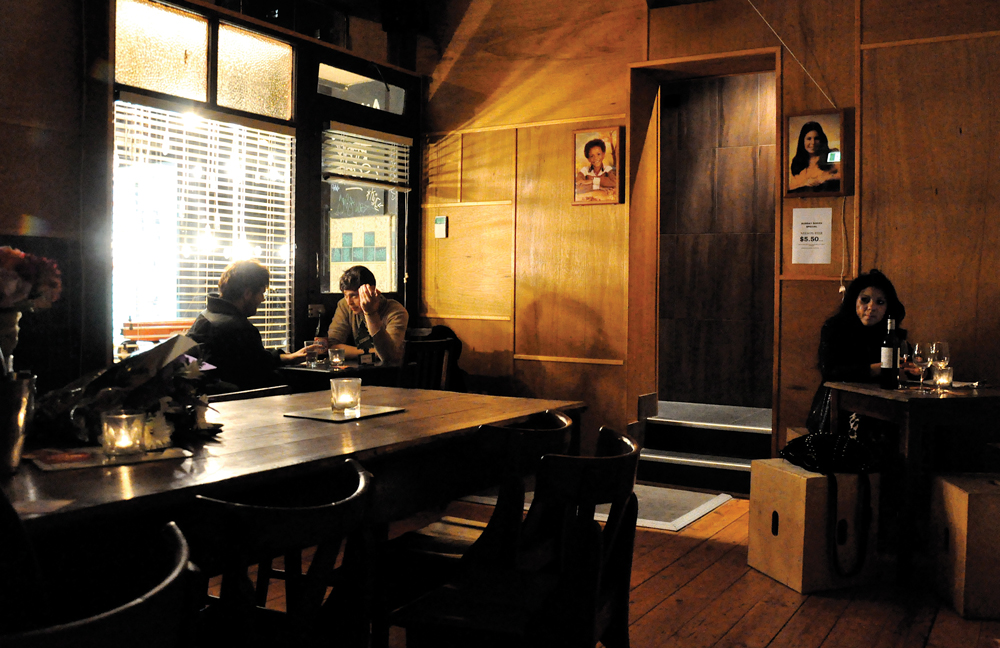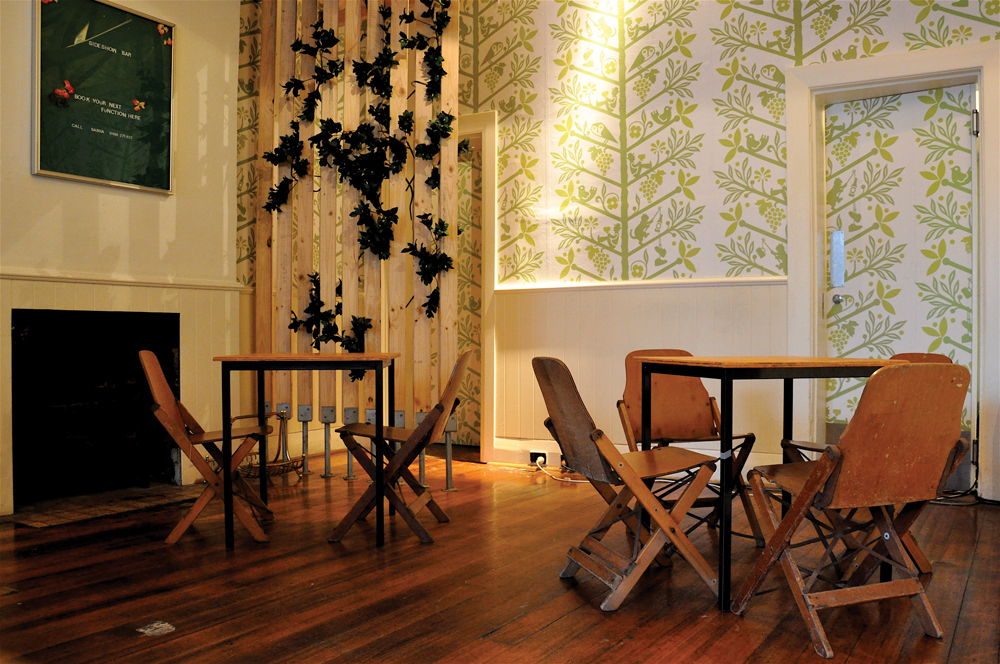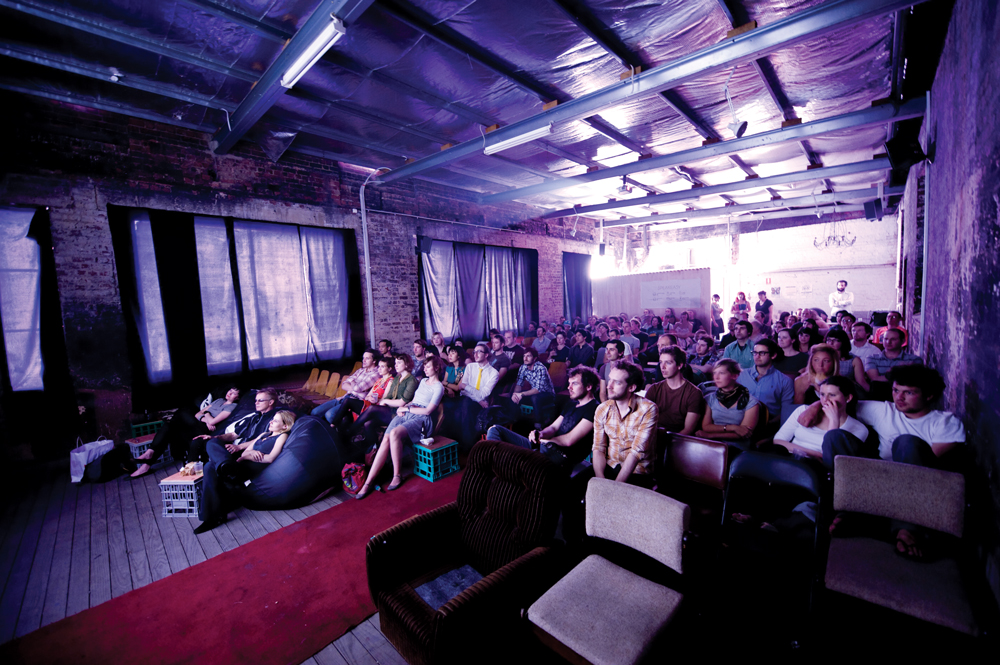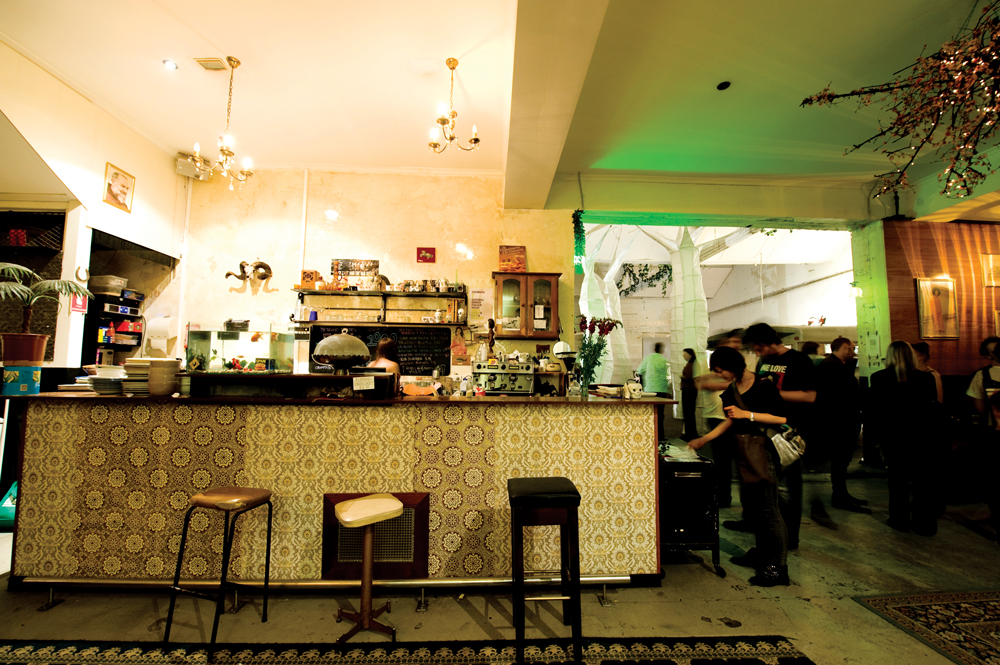Jerome Borazio
 ‘St’ Jerome Borazio takes venue on a tour through the back alleys of his mind.
‘St’ Jerome Borazio takes venue on a tour through the back alleys of his mind.
Photo: Corey Sleap
Jerome wants me to meet him in his element… a St Kilda Football Club ‘Young Guns’ luncheon. The dress code is ‘business attire’, which set me on edge a little — a Collingwood supporter without a suit — I’m feeling akin to a lamb to the slaughter, in sheep’s clothing no less. The morning of, Jerome gives me a courtesy call. He’ll be “the guy wearing jeans and a red t-shirt”. Confused, I make mention of the ‘business attire’. To which he reassures me, “We conduct a different business don’t we”. “Yes!” I exhale, “yes we do.” I get off the phone and with my heightening unease put to rest, slip into jeans and a shirt, with a tie in the back pocket for insurance. In an instant ‘his element’ became mine too.
LIFE OF JEROME
Jerome is Jerome Borazio, the owner of an eclectic collection of Melbourne bars and cafes that over time has included the likes of Fringe, Softbelly, The Wayside, Public Bar, Fantasia, Shittown, Sister Bella, Pushka and Birdbrain among others. His latest acquisitions are the Worker’s Club, which used to be the Rob Roy (an institution on the Melbourne live music scene), and 1000 £ Bend, a multi-function gallery, café and cinema. To some he may be best known as the namesake of the multi-city St Jerome’s Laneway Festival. But Melbournians will always remember St Jerome’s (St J’s for short). And, who could forget: it was around the corner from David Jones, down Caledonian Lane, on the loading dock, right by the dumpsters. That’s right, the one with the wire fence, milk crate ‘chairs’ and dozens of people grasping Coopers longnecks. It was the laneway bar that revolutionised disused spaces and turned laneways from subcultural anomalies into something that’s become synonymously Melbourne.
Jerome wasn’t the first but he was the best: the heady mix of an off the beaten track loading dock for a venue, no expectations, a willingness to embrace anyone that would embrace it, and the fact it was a bloody big success, lends St Jerome’s a special place in Melbourne’s history. Of course, St Jerome’s is now deceased but that doesn’t stop Jerome constantly fielding questions about it — he’s even helping a student write her thesis on the impact of the Coles-Myer development that sealed its fate.
And, why was Jerome so successful? He’s a true believer. He’s from the laneway culture. He’s like a cross between a doting father, and pseudo-saint of a rag-tag, backstreet family. Inviting poor souls, including some of the city’s best street artists and musicians, to jump on the bandwagon. Take Monkey, he just happened to be on the same tram as Jerome’s sister one day, offered to help out with the St J’s fitout and ended up designing a large chunk of Sister Bella. Now he’s the head chef at 1000 £ Bend. And some of the members from the band Temper Trap used to work for Jerome. Dougy the singer was apparently hopeless, but Jerome kept him on anyway, he had that personality you could bank on turning the average night into something special. Jerome’s sense of his employees’ worth seems to run deeper than a Friday night till receipt. His intuition uncovers the designer in a rag-tag city urchin, and an entertainer in a hopeless waiter. With plenty of talent taking shelter under his roof, his question is “why would I use anyone else?”
“In our organisation I’ve always given the staff a lot of liberty to drive the projects. And while we spend a lot of time discussing things, our ideas will start out at one point and end up totally different. I don’t feel under pressure to try and out-do my last project. I just like to try and do what feels right. I’ve lived in the Melbourne CBD for 15 years, it’s a pretty competitive place and I guess I don’t really get involved in that competition… to make a better looking store, a bigger club or better restaurant. For me, as long as I’m comfortable producing what I’m doing, I’m happy about it.”
THE MAN BEHIND THE NAME
Back at the Worker’s Club, Jerome is stressing over a blown light globe. He’s never stressed about something so trivial at any of his other venues and it’s worrying. If a light globe went out at St Jerome’s it could stay unreplaced, put it down to aesthetic, apathy, or an awareness that it was lighting milk crates on a concrete loading dock, fact of the matter is, perfection is inconsequential at Jerome’s other venues, so why the hair pulling? Maybe it’s because every one of his venues has that touch of ‘St’ Jerome, the patron saint, about it, and perhaps that’s what he can’t wrap his head around yet at the Worker’s Club — where he belongs.
Step back a couple of decades, and he would actually belong across the road at The Champion Hotel, where he grew up. Jerome’s revitalisation of The Worker’s Club is a nostalgic return to his roots, and part of a hopeful bid to bring back a slice of that old style hospitality to Melbourne. He proves his point when we stop in at his favourite pub on the way across town to 1000 £ Bend. It’s temperate late-Winter weather and Jerome is in thongs, everyone else is camped round tables in steel-capped boots. It’s lowest common denominator stuff, really just a traditional local pub, with books in the bookshelves, a few older gents manning the bar and it’s absolutely packed. The only thing strange about it is it’s in the middle of the CBD — where fitouts have a short shelf life — and not some country town. His point is that this is what matters — beer and a place to get together with mates — everything else is optional.
THE SAINTLY FIGURE
On cab rides, Jerome slides into the front seat without hesitation and directions for the cabbie punctuate a wider discourse about the state of youth today and why we have so many issues with violence. St Jerome is a philosopher, he mulls over the lack of attention to outer suburbs and the train connections after dark, making connections between juvenile drinking and a downward spiral that, if the inclination is there, could end in petty theft or worse. He’s frightened by that environment; a product he considers of day-to-day monotony in a suburban bubble. He’s not a stranger to it all, he talks out of the experience of a boy that grew up in the Western suburbs. He wonders how many people will show up at his funeral, and whether speculating about it is too morbid. He passionately proposes ideas as if convincing me is as important as convincing a government official. Things like a dedicated aboriginal AFL team that would serve as a dream foundry for a people whose culture is built on dreams, rather than naming a park after them. And he abhors drink driving as a completely unnecessary endangerment of someone else, proclaiming that “human beings can be so intelligent, why do stupid things like that?”
He hates being told what to do by government bureaucrats who live well out from the CBD. But being at loggerheads with regulatory bodies who don’t have a vested interest in the city seems just part of his everyday life. “Shutting bars at one o’clock, it’s not necessarily the answer. We need to educate, and you’re not educating by hitting someone with a fine. We’re the ones experiencing the change on the ground. Had they bothered to consult people like me or other people that are at the coalface everyday, they could probably get some really relevant real-life information as opposed to implementing a lockout here or a lockout there. They should consult more, not have an ‘us versus them’ situation. It’s difficult, because the city changes so quickly, but we have an international reputation we need to uphold.
“I thank my lucky stars we’ve never had a violent incident in any of my venues. I put that down to good management, good RSA, and a loyal clientele that we’re able to manage in the event that they get a little drunk, and say, ‘Hang on, you’ve had too much, come back tomorrow’. That’s our policy; we’re pretty vigilant on it because the last thing you ever want is violence. And it’s not just the reputation of the place, but imagine if somebody got seriously hurt. It took me a long, long, long time to learn to go to sleep because I’d be waiting up for that phone call that this or that had gone on.”
This mile-a-minute treatise is just who Jerome is. He’s an action figure, a fast mover. One of his latest passion projects is St Jerome’s wine, and is in talks with a brewer about putting out St Jerome’s beer. He’s not adverse to partnerships, but when he has an idea, he wants to act on it quickly and understands how potentially damaging that can be to a working relationship. He’s a big believer in projects unfolding organically, with a mindset that’s tuned more towards ‘what’s the worst that could happen?’ than walking around town thinking he’s some Joe Cool for designing a bar of distinction.
LANEWAY FESTIVAL — THE FESTIVE SPIRIT
Jerome learnt the power of live music from an early age, though not from his parents — his dad was a blues man, and his mum was a concert pianist at the age of 13 — but from a deaf guy and an Italian who couldn’t speak a word of English. “I was at a festival and one of the people that turned up to this group was a deaf guy, and being a young kid I was thinking, “What the hell is a deaf guy going to do at a music festival?” But the thing is, he could feel the vibration of the music. He was so excited over the music it was incredible — the music took him wherever he wished to go. Another time, a friend of mine, an Italian girl, met a guy in Italy and brought him over to meet me, but he didn’t speak any English. It was quite embarrassing, I have half an Italian heritage, but I only understand the swear words of course. He wanted to go to Phillip Island. What I remember most about the trip is, we could not communicate with one word, but when we put the music on he could connect automatically.”
It’s these lessons that Jerome took into his music festival partnership with long-term friend Danny Rogers, who had taken to the music business while Jerome went to the pubs. St Jerome’s Laneway Festival is now one of the widest running festivals in Australia, taking in Adelaide, Brisbane, Melbourne, Sydney, Perth, and now Auckland. Last year, at the Melbourne leg of the Laneway tour, it seems people were not moved enough. A couple of hiccups in crowd capacities, and outrageously, some crazy death threats, had the pair rethinking the festival, eventually relocating the Melbourne leg to just outside of the CBD.
But with the festival bearing his name, it’s only adjusted Jerome’s resolve to make it bigger and better. “It’s been a bit of a whirlwind, especially with Laneway expanding the way it has. While we acknowledge there were a couple of hiccups last year, more through corporate and regulatory bodies than our own doing, it’s expanded to Auckland. We rang back every one of the 120 official complaints, really considered what they had to say, re-worked the Melbourne situation over and over again, and we believe we’ve got it right.
What I found interesting was nobody referred to the other 19 festivals that have run smoothly — the same year we were canned in Melbourne, we were heralded as the best festival in Perth ever, in our first year there! Some of the death threats and the rest of it were just out of control. Did anyone forget that people have died at other festivals? Just because you didn’t get to see Girl Talk… I mean get over it.”
JEROME HEARTS MELBOURNE
Notwithstanding the odd death threat, Jerome remains intensely patriotic about Melbourne. He’s philosophical about Lord Mayor Robert Doyle spending almost $150,000 with a highly credentialed Sydney-based firm to develop Melbourne’s logo — although he reckons there’s a ton of Melbourne artists who could have done it better and more economically. “I love Melbourne. There’s such a good community in the CBD: artistic, lively, and has a lot of integrity, especially on the food side of things. I’ve travelled overseas a fair bit, but I’m not really attracted to moving or living in another place. It’s always great to go and have a holiday in another place, and I normally like to take the good bits out of it and apply it to here.”
Jerome has taken the travelling laneway festival around the country, but despite having owned a number of Melbourne venues he hasn’t been lured by any prospects out of state. Though not stoically so, he remains bound to his hometown. “We’ve been approached by people in Sydney, and while they reckon they’ve relaxed the licensing laws, if you do the research, they haven’t really allocated that many small bar licenses yet. We would need to have something that was already open that we could renovate, which is not what we usually do. We prefer to find unique disused spaces that we can then breathe life into. That’s the challenge that really works for us.
“The St. Jerome’s style venue could be well received in Sydney. Putting it in one of the flourishing suburb areas wouldn’t be of any benefit to Sydney, but having it in one of the back laneways in the CBD could be of interest.
“Personally, I really find the two polar opposites. I’ve spent a lot of time in Sydney, and it’s so picturesque and beautiful. But I love the prettiness of Melbourne, the super-strong art scene, the talent of live music and everything that is generated in the urban CBD. And that’s the difference for me between the two.”
Jerome and his merry gang may not have started up in Sydney yet, but word of their laneway expertise has stirred up the Perth council to see what it would take to wake up their sleepy back streets. “We’ve spent the last year working with the East Perth Regional Authority on a development over there. We gave them the whole spectrum of different ways we could activate their laneways. Putting one bar in one laneway won’t necessarily revive Perth’s CBD, but activating 15 lanes with not only bars, but record stores, music stores, designer shops and hairdressing salons. The plan was to activate all their laneways at once but still organically with local people, builders, young people — that was really important.”
THE SECRET TO SUCCESS
There are only three rules Jerome makes blatantly clear to his staff: one — No warm beers. Ever. Two — Never be late, you only let the people you’re working with down. And three — The customer isn’t always right, after all, you’ve served them a few beers and they’re probably a touch emotional. And if staff are struggling, he wants to know, “Just tell me,” he says, “I can’t guess or pretend to understand 100,000 different emotions every week. It’s all about how they feel. What happened to hospitality? People forget that when the lights go down, that staff are your communication.” And despite the customer not always being right, Jerome does think they should be respected: “I get freaked out sometimes when I go to places where waitresses and waiters have a heap of attitude. I don’t expect special treatment. But here’s a simple idea: I don’t feel like cooking at home, you cook here, I’m coming to your place, and I just want to get some food.”
Many people have kicked themselves for not coming up with the loading dock idea first. But it seems so simple, it must be genius. Then again, Jerome’s reasoning for starting St Jerome’s and his ethos that dictated the way it ended up was surprisingly oblique. “Well being a resident I didn’t think on a Friday night that I had to put on a suit or some special outfit just to have a beer in a bar. So while I live in an apartment, I needed a backyard or a place where I could hang out and have a good time. After all, you’re already under enough pressure in your job, work environment, from your girlfriend or boyfriend, or whatever happens in your normal world. Why do you want to come to a bar and be put under more? You just want to go and have a beer — a really simple Australian thing to do.”
The whole ‘anytime, chilled out, backyard party’ idea struck a chord — the books showed a Tuesday at St Jerome’s was about as profitable as a Friday. But when I probe a little further into his narrow assessment, Jerome yields a wider, more workaday target. “And I mean, you work in an environment like a David Jones or somewhere, any of those towers — it’s nice to be able to get out during the day. The thing is, if you drink coffee or you don’t make your lunch at home, you’re basically forced to buy city product and that becomes very expensive. What I like to be able to do is provide a great product at a reasonable price. So if you drink coffee, I don’t think it’s reasonable to pay $4 for coffee every single day, so I like to do $2 or $2.50 coffees. It makes it accessible and it’s not a stress to do it. It’s about the balance.” In fact, the suits did frequent St Jerome’s, at least in the beginning. And that was part of the wonder of it, that worlds combined more than collided and everyone could have a little giggle at the irony of a businessmen dressed in Armani paying to drink beer in a gutter. Only in Melbourne.
Summing up, Jerome puts it simply, “You couldn’t criticise St J’s, we didn’t promise you anything.” And indeed, they didn’t. They didn’t even promise us something that would stick around. Five years after its inception Myer decided it wanted its dock back, and forced the newly homeless to shift lanes. But there’s a taste of St Jerome if you can find Sister Bella behind the dumpsters, or if you can squeeze into Pushka for a coffee, or catch an arthouse flick or gallery instalment at 100 £ Bend, and surely soon enough, you’ll even get that saintly vibe at The Worker’s Club. — Mark Davie




